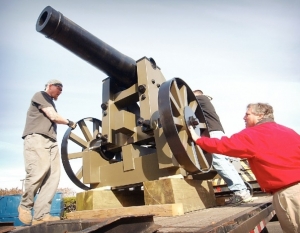Civil War-era cannon headed for Fort Macon
By Phyllis Moore
Published in News on December 14, 2010 1:46 PM

News-Argus/MICHAEL K. DAKOTA
Wayne Community College and the North Carolina Park System combined efforts to build a Civil War cannon replica for Fort Macon Park. The cannon is being delivered Wednesday. Here, Kyle Brownstead, left, and Kirk Keller prepare the cannon to be moved.
A 7,000-pound, 20-foot Civil War-era cannon replica built at Wayne Community College over the past 18 months is set to depart for its new home on Wednesday and the public is invited to the send-off.
More than 100 students, instructors and staff from the mechanical engineering, machining and welding technology programs combined efforts to create the full-scale replica for Fort Macon State Park, located near Atlantic Beach.
The project incorporated drafting, designing, machining and welding, officials said.
"The cannon that is down there now is a replica," pointed out Chad Pate, welding technology instructor. "With the salt air and the beach atmosphere, it doesn't last long."
Construction of the present fort began in 1926 and was garrisoned in 1834. It opened as North Carolina's first functioning state park in 1936 and is the state's most visited park.
The need arose to replace the cannon, originally used in defending Confederate Eastern North Carolina, because its wooden carriage was rotting due to coastal winds and sea spray.
The latest version on the site has been there for probably eight years, Pate said.
"They say it will only last eight to 10 years or so. What's down there is wood and steel. We're using all aluminum construction, so we're hoping it will last longer, maybe 20-plus years.
"Obviously you don't know with salt air, it's hard to predict. But by welding aluminum construction, it's going to hold up better."
Students studied 1840s-era drawings of the original carriage and worked to adapt them to today's technology.
"The engineering and drafting students here went through those and we tried to draw some to keep them as close as we could to the original," Pate said.
The carriage and chassis were created out of rectangular aluminum tubing. The 5,200-pound barrel that the pieces hold was poured at a foundry in Maryland, Pate said.
"It's a true live-firing barrel," he noted.
Officials said the version will not just be for display. It will also be fired during park events and is capable of firing a blank powder charge of five pounds.
The cannon made its first public appearance locally last weekend at the Goldsboro Jaycees and Pikeville Christmas parades. It was also incorporated into an event at Goldsborough Bridge Battlefield on Saturday and is currently on display between the Wayne Learning Center and Dogwood Building on the front of the WCC campus.
On Wednesday morning, it will be transported to Fort Macon, where it will become a permanent exhibit. In mid-January, there will be a dedication ceremony and unveiling of a plaque engraved with "Designed and Fabricated by Wayne Community College."
Before its departure Wednesday, the public is invited to assemble at 8 a.m. to enjoy doughnuts and coffee and learn about the 18-month efforts from WCC and N.C. Division of Parks and Recreation personnel.
The project reportedly saved the N.C. Division of Parks and Recreation an estimated $20,000.
At times along the way, though, there were challenges unique to having it constructed on a community college campus.
"We knew it was a year-plus (project), but being a college, students graduate, you hope to have enough students come in to finish the project," he said. "In the last six months, we have just been putting the final touches on it."
While admittedly "very relieved" that the cannon is complete, Pate said it is a proud accomplishment for students and staff.
"It gives them a real-life manufacturing experience," he said. "It's really given the students of Wayne Community a good sense of teamwork, working together with other departments, working together with other people.
"That's some of the satisfaction that I have seen, the departments coming together and working together, the students getting some self-satisfaction, taking pride in their work."
